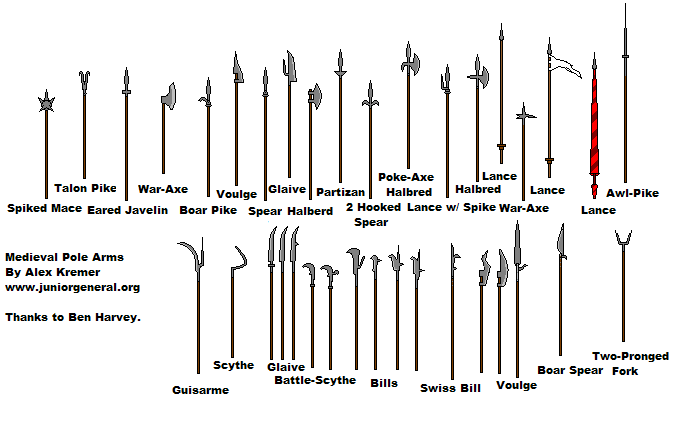Howdy, Stranger!
It looks like you're new here. If you want to get involved, click one of these buttons!
If you have an email ending in @hotmail.com, @live.com or @outlook.com (or any other Microsoft-related domain), please consider changing it to another email provider; Microsoft decided to instantly block the server's IP, so emails can't be sent to these addresses.
If you use an @yahoo.com email or any related Yahoo services, they have blocked us also due to "user complaints"
-UE
If you use an @yahoo.com email or any related Yahoo services, they have blocked us also due to "user complaints"
-UE
Hipster Spears (no not the Starbucks Britney Spears, the Pokey things on Fire Emblem, you dick)

Like, I get the Guisarme was for pulling niggas off their horses, and sounding like an instrument of volatile relentless rape, but what's the functional difference between a Halbred and a Halberd?
Not listed on here: The Ranseur. This was my slutty OC's primary melee weapon, and it doubled as her stripping pole when she wasn't busy tearing thirsty mother fuckers up with it. However, I don't really get it. What was the crescent blade for? Why not just go with a trident? it has more points.
Also, aren't Tridents the evolutionary descendants of spears?
Like, isn't having more points > one point?
Like, what's the monkey of the spear evolutionary line? What's the homo sapien? or homo longinus?


Comments
or, was the three points important somehow?
BURN THE SPY, THEY KNOW MORE THAN THEY'RE SHOWING
His scythe in Castlevania is only really intimidating because it's big and floaty and goes everywhere and gives him huge range and does all sorts of weird stuff. And is probably sharp on both sides. Otherwise it's arguably just used like a pick-axe.
The granddaddy of polearms was the pointy stick. Then somebody got the idea to actually put some sharp thing on top of that stick, like some kind of pointy rock, and so the spear was born.
Trident, as far as I know, was originally a fishing spear. In Greek mythology it was an attribute of Poseidon, presumably because of that fact. That's how it got all that aquatic symbolism. I guess though that it is simpler to make a robust spear than a robust trident, with a limited difference in practicality.
But that is not to say there weren't such things as combat pitchforks in the Middle Ages. I think some cities even kept a number of them in their arsenals. Mind you, to see polearms as a simple tree where one design leads to more developed others, is not really the best way of thinking. Back in the day, lots of weapons came to be when somebody took a random item and fastened it to a pole. So, if you want to really make a genealogical tree, it probably should start with a stick and then it would branch out depending on what to put on the top of it. A tip - spear. A big knife - glaive. An axehead - then it would be either a bardiche or a halberd, depending on some other factors.
Now, talking about winged spears. You mean the early medieval model? I remember reading that while those little wings on the sides are commonly thought to prevent the spear from getting lodged in the enemy, they actually were used in spear fencing. At the moment I'm in no position to swear by it, however.
Then there were the rest of spear-like weapons with wings and stuff on the side. Most of them Renaissance-era with Italian names, if I'm not mistaken. Can't say much about them, besides the fact that the wings tended to be hooks for unsaddling horsemen or just to give the weapon a bigger chance of wounding hit.
Being reminded of that, though, brings me to a broader point about spears in media: spears and pole weapons tend to be weapons used by female characters. This is especially true in Japanese media, where the naginata is considered primarily feminine for some reason (apparently something to do with it being a traditional weapon of samurai's wives), but it seems to me that female characters in general tend to have a greater affinity for polearms than swords. If I had to guess, it's that many works of fiction tend to portray spears as focusing more on range, agility, and graceful movement while swords tend to be portrayed as having a greater focus on direct, straightforward attacks and physical strength: so cultural norms would make men seem more appropriate for swords and women more appropriate for spears.
But I see more bitches with bows than I do with spears. On an unre note the jumonji yari looks a lot like the Ranseur I was talking about. Along with a Spetum. So, what is the difference between a Jumonji Yari, Ranseur and Spetum?
I was thinking Western fantasy likes to give girls bows.
--edit--
Vorpy: yari is Japanese, the others are European. In general it's not uncommon to find more names than weapon types, especially when it comes to polearm variants. The distinguishing features may be the length of these wings, whether they are sharp or not, and if yes, then on which side.